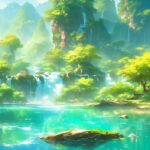Imagine a creature so massive it dwarfed even the largest animals alive today. That’s Argentinosaurus huinculensis – a true titan of the Late Cretaceous period. Unearthed in the fossil-rich heartland of Argentina, this colossal dinosaur continues to amaze and baffle scientists. Let’s journey into the world of Argentinosaurus, uncovering fascinating details about its life, environment, and the mysteries that still surround this ancient behemoth.
A Glimpse into a Giant’s World
Picture a landscape dominated by lush greenery, meandering rivers, and vast floodplains – the world Argentinosaurus called home. This massive herbivore, with a neck longer than a bus, likely spent its days wading through these waterways, using their buoyancy to support its incredible weight. We’re talking about an animal that could potentially reach lengths of up to 115 feet – longer than three school buses parked end-to-end! As for its weight, imagine a herd of 13 African elephants – that’s how heavy Argentinosaurus may have been!
Piecing Together the Puzzle of Argentinosaurus
How did Argentinosaurus grow to such a mind-boggling size? Scientists are still trying to figure that out! Some theories suggest that their long necks, perfect for reaching high into the trees, allowed them to access a nearly endless supply of leaves. It’s also possible that their slow metabolism and the warm, lush environment of the Late Cretaceous provided ideal conditions for these gentle giants to thrive and grow to colossal proportions.
While the discovery of Argentinosaurus bones is incredible in itself, it’s important to remember that we’re talking about a living, breathing animal that played a crucial role in its ecosystem. Imagine Argentinosaurus lumbering through its prehistoric stomping grounds, its massive feet leaving footprints large enough to swim in! This gentle giant shared its world with a variety of other dinosaurs, some small and some equally enormous.
Despite the incredible discoveries made so far, Argentinosaurus remains shrouded in mystery. Every bone fragment, every fossilized footprint, offers tantalizing clues about its life, behavior, and the world it inhabited. Scientists are hard at work, using cutting-edge technology to piece together the intricate details of Argentinosaurus’s existence. We may never have all the answers, but that’s part of what makes studying dinosaurs so captivating. Each new discovery opens a window into a world lost to time, reminding us of the incredible diversity of life that has graced our planet.
Was Argentinosaurus the Biggest Dinosaur?
We’ve all heard of the Argentinosaurus, a creature longer than three school buses parked end-to-end, weighing about the same as a dozen African elephants. This massive dinosaur was once thought to be the biggest to ever roam the Earth. But the dinosaur world might be even more awe-inspiring than we thought.
The discovery of Patagotitan mayorum in 2014 sent shockwaves through the paleontology community. This colossal dinosaur, unearthed in Patagonia, Argentina, might just be the new champion of size. Picture this: a creature stretching a whopping 122 feet and weighing in at a mind-boggling 77 tons. This means Patagotitan wasn’t just big, it was enormous, dwarfing even the mighty Argentinosaurus!
Let’s not forget about Argentinosaurus huinculensis, discovered in 1993, also in Argentina. Based on the fossil evidence we have (which isn’t complete), scientists believe Argentinosaurus measured somewhere between 98-115 feet long and weighed a hefty 65-80 tons – still incredibly massive, even if it’s not the absolute largest anymore.
And the story doesn’t end there. In 2021, paleontologists made another exciting discovery – a single bone fragment, possibly from a titanosaur, in Argentina. Could this be from a dinosaur even larger than Argentinosaurus? It’s certainly possible, but it’s too early to tell. We need more than a single bone fragment to make accurate size comparisons. The hunt for more fossils continues!
The Largest Dinosaur: An Ongoing Investigation
We know Argentinosaurus was massive, but another contender for the title of “biggest dinosaur ever” is Patagotitan mayorum, a titanosaur that roamed the earth during the Late Cretaceous period. Fossils of this behemoth were unearthed in Argentina back in 2014, and it’s estimated to have weighed a mind-boggling 77 tons! To put that in perspective, that’s like 12 adult African elephants! This colossal creature stretched a whopping 122 feet long – longer than three school buses parked end to end!
However, the world of paleontology is full of surprises. Enter Bruhathkayosaurus, another colossal contender discovered in India in 1987. Now, here’s where things get a little tricky. The Bruhathkayosaurus fossils are incomplete, making it difficult to accurately estimate its size. However, some paleontologists suggest that this dinosaur could have been even larger than Patagotitan, potentially reaching a staggering 80 tons and a length of 131 feet!
Imagine walking alongside these gentle giants! Despite their imposing size, both Patagotitan and Argentinosaurus were herbivores, content to munch on leaves and other plant matter. They were the true gentle giants of their time, shaping the Late Cretaceous ecosystem in ways we are still trying to understand.
The quest to crown the largest dinosaur is an ongoing one. New discoveries and further research could change what we know today. These incredible creatures continue to captivate our imaginations and remind us of the awe-inspiring power of nature and the mysteries it holds.
What Killed Argentinosaurus?
We might never know exactly what caused the death of any particular Argentinosaurus since we only have their fossilized bones to go by. However, experts think it’s likely that massive meat-eaters like Giganotosaurus – one of the biggest meat-eating dinosaurs ever discovered – played a role.
Now, a healthy adult Argentinosaurus would have been a formidable opponent. However, young, old, sick, or injured individuals were probably more vulnerable, similar to how lions target the weakest zebras in a herd.
Predators like Giganotosaurus probably weren’t the only threat to Argentinosaurus. Environmental changes, such as shifts in vegetation and habitat, likely played a part too. Even the largest animals rely on having enough food and water to survive. So, while Giganotosaurus might get the glory as a potential Argentinosaurus slayer, the bigger picture is likely much more complex and points to a combination of factors.
The extinction of Argentinosaurus, like many prehistoric creatures, remains a fascinating puzzle with multiple pieces. Ongoing research and new discoveries continue to shape our understanding of these magnificent creatures and the world they inhabited.
Interested in knowing about other fascinating dinosaurs? Explore the Archaeopteryx page to learn more about one of the legendary feathered dinosaurs, or visit the Allosaurus page to delve into the world of this well-known theropod from the late Jurassic period.
- Discover Long Black Pepper: Flavor & Health Benefits - April 25, 2025
- Shocking Twists: The Grownup Review: Unreliable Narration - April 25, 2025
- A Quiet Place Book vs Movie: A Deep Dive - April 25, 2025

















1 thought on “Argentinosaurus Huinculensis: Unveiling the Colossal Mystery of the Late Cretaceous”
Comments are closed.